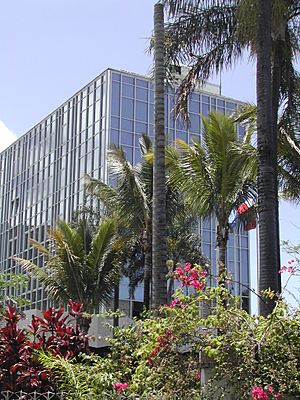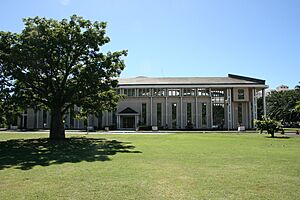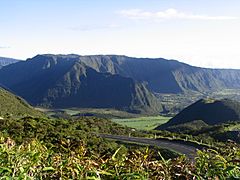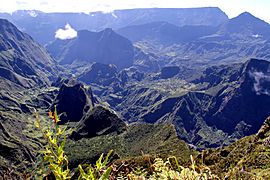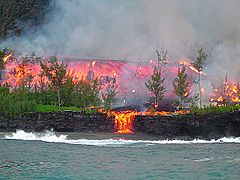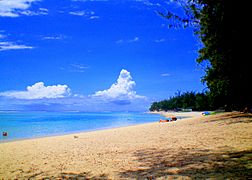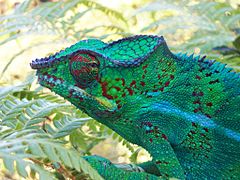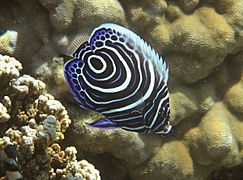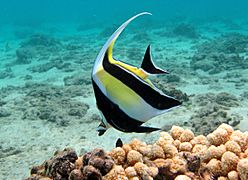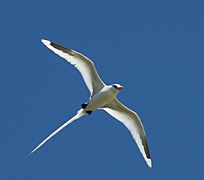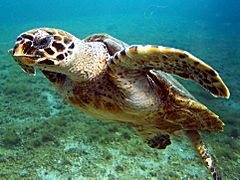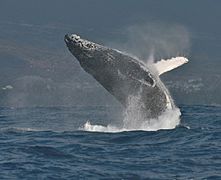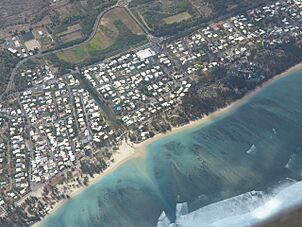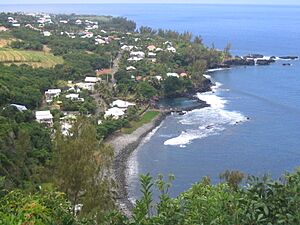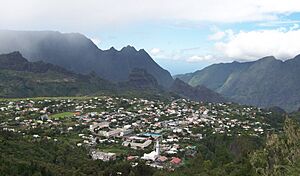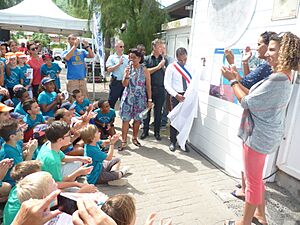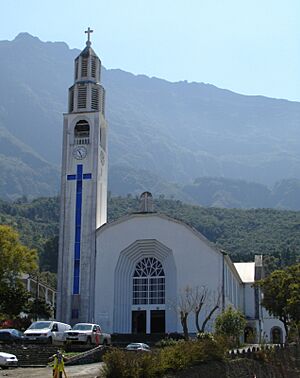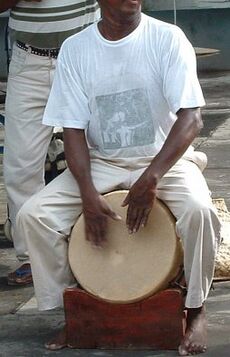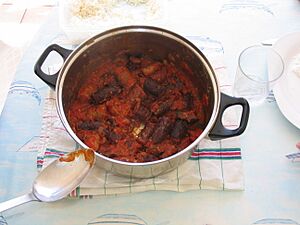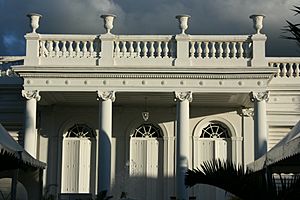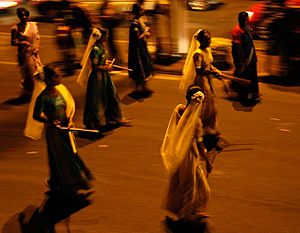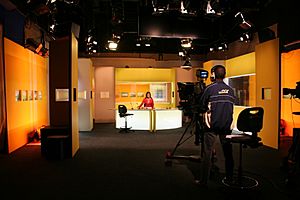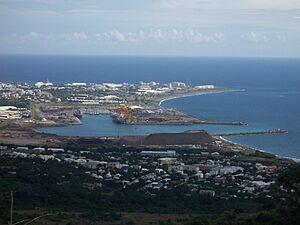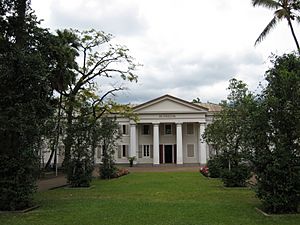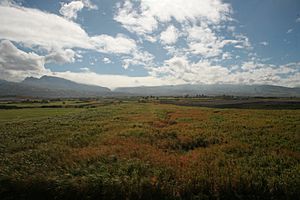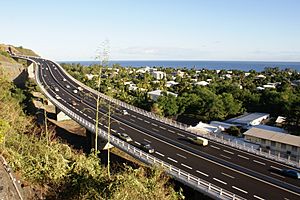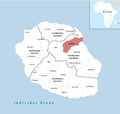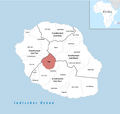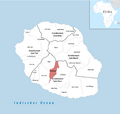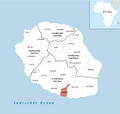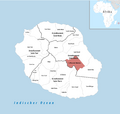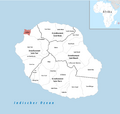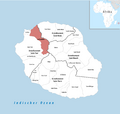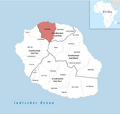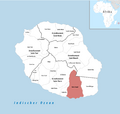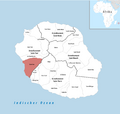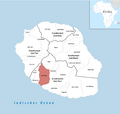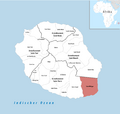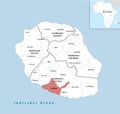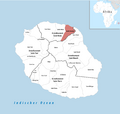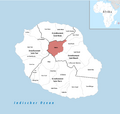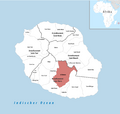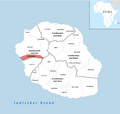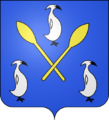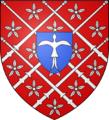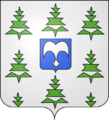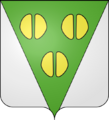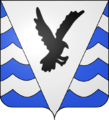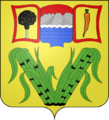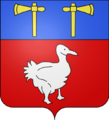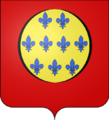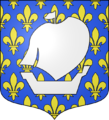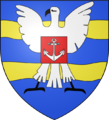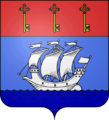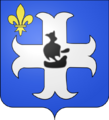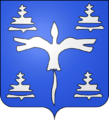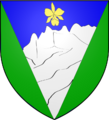Réunion facts for kids
Quick facts for kids
La Réunion
|
||
|---|---|---|
|
||
| Motto(s): | ||
| Anthem: La Marseillaise ("The Marseillaise") | ||
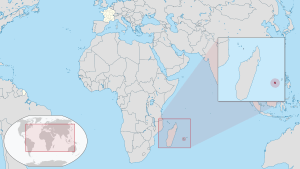 |
||
| Country | ||
| Prefecture | Saint-Denis | |
| Departments | 1 | |
| Area | ||
| • Total | 2,511 km2 (970 sq mi) | |
| Area rank | 15th region | |
| Population
(January 2024)
|
||
| • Total | 885,700 | |
| • Density | 352.73/km2 (913.56/sq mi) | |
| Demonym(s) | Réunionese | |
| GDP (in 2023) | ||
| • Total | €23.2 billion | |
| • Per capita | €26,300 | |
| Time zone | UTC+04:00 (RET) | |
| ISO 3166 code |
|
|
| Currency | Euro (€) (EUR) | |
| Website |
|
|
La Réunion (pronounced 'La Ray-oo-nyon') is a beautiful island in the Indian Ocean. It is an overseas department and region of France. This means it is a part of France, even though it's far away!
The island is part of the Mascarene Islands group. It is located about 679 kilometers (422 miles) east of Madagascar and 175 kilometers (109 miles) southwest of Mauritius. As of January 2024, about 885,700 people live there. The capital and largest city is Saint-Denis.
La Réunion was not inhabited until French settlers arrived in the 17th century. Its warm, tropical weather was perfect for growing crops like sugar. People from East Africa were brought to work on these farms. Later, workers from Malaysia, Vietnam, China, and India also came. Today, many people on the island have mixed backgrounds. The main language spoken is Réunion Creole, but French is the official language.
Since 1946, La Réunion has been governed like a French region. It is also one of the "outermost regions" of the European Union and uses the Euro currency. France keeps a large military presence on the island because of its important location.
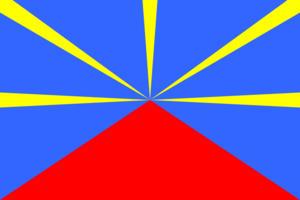
Contents
What's in a Name?
The French took control of the island in the 17th century. They first called it Isle Bourbon after the House of Bourbon, the ruling family of France at the time.
During the French Revolution in 1793, the name was changed to "La Réunion." This name means "meeting" or "assembly" in French. It was chosen to honor a special meeting of French groups that happened before a big event in the revolution.
The island's name changed again in the 19th century. In 1806, it was called Isle Bonaparte after Napoleon. But in 1810, it went back to Isle Bourbon. Finally, in 1848, after another French revolution, it was officially renamed La Réunion.
Today, the name is usually written as "La Réunion" with a capital "L" to show that "La" is part of the island's official name.
A Brief Look at History
People have lived on La Réunion since the 17th century, when settlers from France and Madagascar arrived. Slavery was ended on December 20, 1848, a day still celebrated on the island every year. After slavery ended, many workers from places like South India came to Réunion. The island officially became an overseas department of France in 1946.
Early Discoveries
Not much is known about La Réunion before the Portuguese arrived in the early 1500s. Arab traders knew it as Dina Morgabin, meaning "Western Island." It might even be on a map from 1153 AD! Sailors from Africa and Southeast Asia might have also visited the island on their way to Madagascar.
The first Europeans to find the area were led by Portuguese explorer Diogo Fernandes Pereira around 1507. The island was named Santa Apolónia after a saint. Another explorer, Diogo Lopes de Sequeira, is said to have landed on Réunion in 1509.
French Settlement and Isle Bourbon
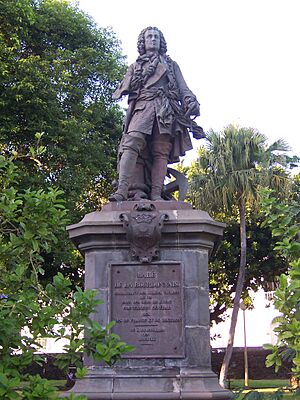
By the early 1600s, the island was still mostly untouched. France officially claimed it in 1642. The island was named Isle Bourbon in 1649. Real settlement began in 1665 when the French East India Company sent the first colonists.
French colonists started large farms, growing coffee and sugar using enslaved labor. From the 17th to the 19th centuries, people from Africa, China, and India were brought to the island as workers. This created a very diverse population. By 1690, most non-Europeans on the island were enslaved.
Changes During Wars
In 1793, during the French Revolution, the island's name was changed to "La Réunion." This was to remove the name linked to the old French royal family.
Slavery was supposed to be abolished in 1794, but authorities in Réunion and Mauritius refused. Napoleon Bonaparte later made slavery legal again in 1802. In 1806, the island was renamed Isle Bonaparte.
After bad weather in 1806-1807, coffee farming decreased. Sugar cane became the main crop because France needed more sugar. Sugar cane is also stronger against cyclones.
During the Napoleonic Wars, British forces took over the island in 1810. The old name, Isle Bourbon, was brought back.
From Colony to French Department
Bourbon Island was returned to France in 1814. Even though the slave trade was condemned internationally, the island continued to bring in many enslaved people. In 1841, a discovery about how to pollinate vanilla flowers helped the island become a top vanilla producer.
On June 9, 1848, the French Republic was announced in Saint-Denis. The island was permanently renamed "Réunion." On December 20, 1848, slavery was finally abolished in Réunion. This day is now an official holiday.
After slavery ended, many foreign workers came to the island under labor contracts. The opening of the Suez Canal in 1869 made the island less important for trade routes. However, the island still modernized with new roads, a railroad, and a port.
During World War II, Réunion was controlled by Vichy France until 1942, when Free French forces took over.
Modern Times
La Réunion became an overseas department of France on March 19, 1946. It has the department code 974.
In 2005 and 2006, La Réunion faced a big outbreak of chikungunya, a disease spread by mosquitoes. About 255,000 people got sick. The French government sent help to get rid of the mosquitoes.
How La Réunion is Governed

La Réunion sends seven representatives to the French National Assembly and three senators to the French Senate.
Island Status
Réunion is an overseas department and region of France. This means French laws apply there just like in mainland France.
The island has a regional council and a departmental council. These councils have similar powers to those in mainland France. The French government is represented by a "prefect." The island is divided into four main areas called districts. Réunion also has 24 towns, called municipalities.
From the European Union's point of view, Réunion is an "outermost region."
Important Location
The location of La Réunion has always been important. In the past, it was a key stop on the sea route to India. Even though it was not the main trading spot, it served as an emergency base.
The opening of the Suez Canal made the island less important for shipping. Today, La Réunion is home to the headquarters of the French Armed Forces in the Southern Indian Ocean. It is also a base for French intelligence systems. Because France owns Réunion, it is a member of the Indian Ocean Commission, which includes other nearby countries.
Towns and Communities
La Réunion is divided into 24 municipalities (towns). These towns are grouped into four larger areas called arrondissements. The towns are quite large, and some include several smaller communities.
The municipalities work together in groups called "agglomeration communities." These groups help manage local services and have their own budgets. Every town in Réunion is part of one of these groups.
Island Geography
The island is about 63 kilometers (39 miles) long and 45 kilometers (28 miles) wide. It covers an area of 2,512 square kilometers (970 sq mi). La Réunion sits over a "hotspot" in the Earth's crust.
The Piton de la Fournaise is a very active volcano on the eastern side of the island. It is over 2,631 meters (8,632 ft) tall. It has erupted more than 100 times since 1640 and is always being watched. In April 2007, it erupted with a huge lava flow! This same hotspot also created the islands of Mauritius and Rodrigues.
The Piton des Neiges volcano is the highest point on the island, at 3,070 meters (10,072 ft) above sea level. It is to the northwest of Piton de la Fournaise. Piton des Neiges means "peak of snows," but snow is rare there. The slopes of both volcanoes are covered in thick forests. Most towns and farms are on the flatter coastal areas.
The west coast has a coral reef system. Réunion also has three large natural "bowls" formed by collapsed volcanoes: the Cirque de Salazie, the Cirque de Cilaos, and the Cirque de Mafate. The Cirque de Mafate can only be reached by walking or helicopter!
-
Cirque de Mafate is a caldera formed from the collapse of the large shield volcano the Piton des Neiges.
Island's Formation and Landscape
La Réunion is a volcanic island that formed about three million years ago with the Piton des Neiges volcano. This volcano is the highest peak in the Indian Ocean. The eastern part of the island has the Piton de la Fournaise, a younger volcano (500,000 years old) that is one of the most active on Earth.
The island's landscape is very uneven due to constant erosion. The center has three huge "cirques" (natural amphitheatres) carved out by erosion: Salazie, Mafate, and Cilaos. Many rivers have also dug deep valleys, sometimes hundreds of meters deep.
Weather and Climate
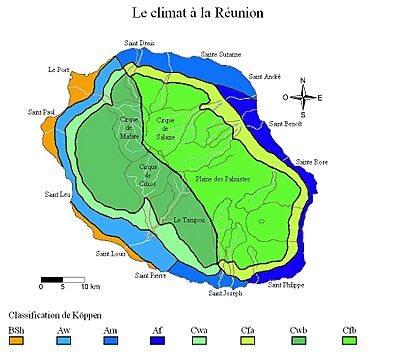
La Réunion has a humid tropical climate. This climate is made milder by ocean winds. The island's tall mountains create many different "microclimates," meaning the weather can change a lot from one area to another.
There are big differences in rainfall between the wet eastern coast and the drier western coast. Temperatures also vary between the warm coastal areas and the cooler highlands.
La Réunion has two main seasons:
- A rainy season from January to March, when most of the year's rain falls.
- A dry season from May to November. However, the eastern parts can still get a lot of rain even in the dry season.
April and December are transition months, which can be either very rainy or very dry.
The driest place on the coast is Pointe des Trois Bassins, with about 447.7 mm (17.6 inches) of rain per year. The wettest coastal spot is Le Baril, with about 4,256.2 mm (167.6 inches) of rain per year. The wettest place overall is in the highlands of Sainte-Rose, with almost 11,000 mm (433 inches) of rain annually, making it one of the wettest places in the world!
Temperatures are mild all year. The change in temperature between seasons is small, usually less than 10°C (18°F).
- In the warm season (November to April), coastal temperatures are usually between 21-24°C (70-75°F) at night and 28-31°C (82-88°F) during the day.
- In the cold season (May to October), coastal temperatures are 17-20°C (63-68°F) at night and 26-28°C (79-82°F) during the day.
In mountain towns like Cilaos, average temperatures are between 12-22°C (54-72°F). The highest parts of the island can even get some frost in winter. Snow has been seen on Piton des Neiges and Piton de la Fournaise in 2003 and 2006!
La Réunion holds world records for the most rainfall in 12-, 24-, 72-, and 96-hour periods. For example, it once received 1.8 meters (5.9 feet) of rain in just 24 hours!
Beaches to Explore
La Réunion has many beautiful beaches, often with barbecues, facilities, and parking.
- Hermitage Beach is the largest and best-preserved lagoon on the island. It's a great spot for snorkeling. It has white sand and casuarina trees, perfect for picnics.
- La Plage des Brisants is a popular surfing spot. Many sports and fun activities happen here. A film festival is held here every November, with movies shown on a big screen.
- Boucan Canot beaches are surrounded by restaurants that cater to tourists.
- L'Étang-Salé on the west coast has unique black sand. This sand is made of tiny pieces of volcanic rock that cooled quickly when lava touched water.
- Grand Anse is a tropical white-sand beach in the south, with coconut trees, a rock pool for swimming, and a picnic area.
- Le Vieux Port in Saint Philippe has green sand! This sand is made of tiny olivine crystals from a 2007 lava flow, making it one of the newest beaches on Earth.
Island Environment
Amazing Plant Life
The plants on La Réunion are very diverse, with many unique species found nowhere else. The island has different plant environments, from the coast to high mountains.
La Réunion has over 850 native plants. Of these, 232 are found only on the island! Many others are found only in the Mascarene Islands. The island's forests are not as tall or dense as some tropical forests, probably because plants have adapted to cyclones. You'll also see many plants that grow on other plants, like orchids, bromeliads, and ferns.
Wonderful Wildlife
La Réunion is home to many birds, like the white-tailed tropicbird. Many bird species, like the Réunion harrier, are found only on this island. The largest land animal is the panther chameleon.
The coral reefs along the west coast are home to sea urchins, conger eels, and parrot fish. Sea turtles and dolphins live in the coastal waters. Humpback whales visit the island from June to September to breed and feed. You can often see them from the shore!
Sadly, at least 19 species that used to live only on Réunion have become extinct since humans arrived. For example, the Réunion giant tortoise disappeared because sailors and settlers hunted them.
-
A juvenile Emperor angelfish
-
A white-tailed Tropicbird
-
A Humpback whale off St-Gilles
Rich Ocean Life
Even though its coral reefs are small, La Réunion's ocean life is very rich. It's considered one of the top ten "biodiversity hotspots" in the world! The coral reefs are home to many fast-growing corals that provide shelter and food for tropical fish.
Recent studies show that Réunion has over 190 types of corals, more than 1,300 types of mollusks (like snails and clams), over 500 types of crustaceans (like crabs), and over 1,000 types of fish.
Deeper waters around La Réunion are home to dolphins, killer whales, humpback whales, and many kinds of sharks, including whale sharks, bull sharks, and tiger sharks. Several types of sea turtles also live and breed here.
Between 2010 and 2017, there were 23 shark incidents in La Réunion's waters, with some being very serious. Because of this, swimming and surfing were banned in some coastal areas.
Coral Reefs
Since the island is relatively young (3 million years old), its coral reefs are not as big as on older islands. They form a broken belt about 25 kilometers (15.5 miles) long along the west and southwest coasts. The largest lagoons are at L'Ermitage, St-Leu, L'Étang-Salé, and St-Pierre.
Protecting the Environment
Since 2010, about 40% of La Réunion is a UNESCO World Heritage Site. This area is part of the Réunion National Park.
Threats to Nature
Coral reefs are very rich in life but also very fragile. In 2009, nearly one-third of fish species were already considered threatened. This is due to pollution, overfishing, and human activities like building near the coast and releasing sewage.
Fifteen species living on La Réunion are on the Red List of threatened species.
People of La Réunion
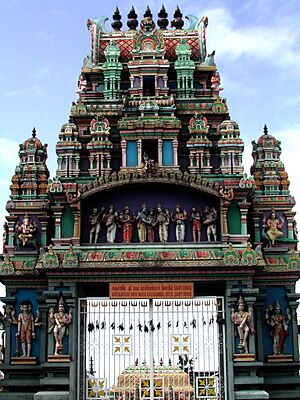
Population Growth
The population of La Réunion has grown a lot over the centuries. In 1654, there were only 13 people. By 2024, there are 885,700!
Major Cities
The largest city area is Saint-Denis in the north, with over 319,000 people. Other large city areas include Saint-Pierre-Le Tampon and Saint-Paul.
Different Backgrounds
At the 2019 census, most people (82.4%) were born on La Réunion. About 11.7% were born in mainland France. A small number were born in Mayotte or other French overseas areas. About 4.6% were born in other countries.
More people from mainland France have moved to La Réunion over the years. At the same time, more people born in La Réunion have moved to mainland France for studies or work.
La Réunion has not had much immigration since World War II. However, in the past, many people came from India, East Asia (like China), and Africa to work on the farms. Their descendants are now French citizens.
The people of La Réunion come from many different backgrounds: African, Indian, European, Malagasy (from Madagascar), and Chinese. Local names for these groups include Yabs, Cafres, Malbars, and Chinois. All these groups came to Réunion over the centuries. They have mixed together since the island's early days, creating a majority population of mixed heritage with a "Creole" culture.
It's hard to know exact numbers for each group because French law doesn't ask about ethnic origin in censuses. However, estimates suggest that people of European descent make up about one-quarter of the population. People of Indian descent (Malbars) are more than 25%, and people of Chinese descent are about 3%.
"Creoles" are people born on the island, no matter their background. They make up most of the population. Other groups include people who recently moved from mainland France (called zoreilles) and immigrants from Mayotte, Comoros, Madagascar, and Sri Lankan Tamil refugees.
Beliefs and Traditions
The main religion on La Réunion is Christianity, mostly Catholic. About 84.9% of the population are Christians. There are also many Hindus (10%) and Muslims (2.15%). Some people follow Chinese folk religions or Buddhism.
Most large towns have a Hindu temple and a mosque.
Special Ceremonies
La Réunion has traditional ceremonies called Les sèrvis kabaré or Servis kaf. These are about honoring ancestors and mix influences from Malagasy, Indian, Comorian, European, and Chinese cultures. People who follow Christianity, Hinduism, or Islam might still take part in these ceremonies.
Island Culture
Réunion's culture is a mix of European, African, Indian, Chinese, and island traditions. The most spoken language, Réunion Creole, comes from French.
Languages Spoken
French is the only official language of Réunion. But Réunion Creole is widely spoken for everyday use. French is used for official things like government and school.
Other languages you might hear include:
- Comorian and Malagasy (from recent immigrants)
- Mandarin, Hakka, and Cantonese (from the Chinese community)
- Indian languages like Tamil, Gujarati, and Hindi
- Arabic (spoken by a small Muslim community)
These languages are mostly spoken by immigrants. People born on the island usually speak French and Creole. Some schools offer Cantonese, Arabic, and Tamil as optional languages.
Music and Dance
La Réunion has two main types of traditional music and dance:
- The sega is a Creole dance with Western instruments like the accordion and guitar. It's a popular ballroom dance on Réunion and other nearby islands.
- The maloya comes from Africa, expressing the feelings of enslaved people. It's unique to Réunion.
Maloya was often performed secretly by enslaved people around a bonfire, using instruments made from plants. It was sometimes banned by the French government because it was linked to movements for independence. The songs often reminded people of the island's history of slavery.
Every December 20, people in La Réunion celebrate Réunion Freedom Day. This day marks the end of slavery in 1848. Many free concerts, parades, and dance shows are held.
Today, maloya is widely accepted and played on the radio. Artists like Danyèl Waro helped bring it back to popularity. Modern versions of maloya, like "maloggae," are also popular.
Urban music styles like hip-hop and ragga dancehall are also growing on the island, influencing young people.
Delicious Food
Réunion's food is usually served with rice. The most common dishes are:
- Carry (or cari): A local version of Indian curry, made with onion, garlic, spices like turmeric, and then fish, meat, or eggs. Tomatoes are often added.
- Rougail: A spicy sauce or dish.
- Civets: Stews.
Dishes are often flavored with ginger or Kaffir lime. Chop suey (with rice) and other Asian dishes are also popular.
Some popular Réunionese dishes include:
- Achards (pickled vegetables)
- Cabri massalé (goat curry)
- Cari poulet (chicken curry)
- Rougail dakatine (peanut rougail)
- Rougail morue (codfish rougail)
- Rougail saucisse (sausage rougail)
- Bouchon (steamed dumplings)
It can be hard to find vegetarian options, as most dishes have meat or fish. Poultry is commonly eaten. A local specialty is tangue civet, made from a type of hedgehog.
Sports and Activities
Moringue is a popular combat and dance sport, similar to capoeira. La Réunion has produced famous athletes, like handball player Jackson Richardson and karateka Lucie Ignace.
The island is known for surfing, with pro surfers like Jeremy Flores coming from here. The famous St Leu break has hosted world surfing competitions. Since 1992, Réunion has also hosted several ultramarathons under the name Grand Raid.
Football (Soccer)
Football is the most popular sport on the island. Over 30,000 people are registered players. Many young people dream of playing at a high level. Some Réunionese players have even played for the French national team, like Dimitri Payet. The island has its own team, the Réunion national football team.
Unique Architecture
Local Creole houses are often symmetrical. Workers would draw a line on the ground and build two identical parts on each side, making rectangular houses. The veranda, an outdoor terrace at the front, is an important part of the house. It was a way to show off wealth. A Creole garden, with local plants, usually completes the house.
Media and Communication
TV and Radio
La Réunion has its own public TV channel, Réunion 1ère, which is part of France Télévision. It also receives channels from mainland France. There are two local private channels: Télé Kréol and Antenne Réunion.
The island has a local public radio station, Réunion 1ère. It also receives French national radio stations. The first private local radio station, Radio Freedom, started in 1981. They broadcast daily news and local information.
Newspapers
There used to be three daily newspapers. In 2024, one closed, and another is now only online.
- Le Quotidien de La Réunion, started in 1976.
- Témoignages, started in 1944, now online only.
Movies and Festivals
Movies have been shown on the island since 1896. La Réunion's beautiful landscapes are often used as backdrops for films and TV shows. Many film festivals are held here. Digital technology now helps local filmmakers create their own movies, often showing the island's multicultural society.
Some film festivals include:
- The Réunion Film Festival (Festival du film de La Réunion)
- The International Film Festival of Africa and the La Réunion Islands
- The Réunion Island Adventure Film Festival
- The Festival Même pas peur (fantasy film festival)
- Écran jeunes and the Festival du Film Court de Saint-Pierre
Internet Access
In the past, internet on Réunion was slower because it's an island far from mainland France. But now, the island has good internet connections and is one of the most fiber-optic connected areas in France!
You can get internet through ADSL, fiber optic cables, or mobile data (4G and 5G). The island has its own internet domain name, .re.
Island Economy

In 2019, the total value of goods and services produced in Réunion (GDP) was about 19.5 billion euros. The GDP per person was about 22,629 euros. This is the highest in sub-Saharan Africa, but it's still less than mainland France.
Before 2008, Réunion's economy was growing quickly. But the global financial crisis caused it to slow down. Growth returned in 2014, and the economy has been improving since then.
Unemployment used to be a big problem, with over 30% of people out of work in the early 2000s. But it has improved a lot, reaching 19.0% in 2023, the lowest in 45 years!
In 2021, about 36.1% of the population lived below the poverty line. This is a big improvement from 2013, when almost half the population was below the poverty line.
Rum is also produced on the island and is exported. Brasseries de Bourbon is the main brewery on the island.
Tourism is Key
Tourism is the most important part of La Réunion's economy. It brings in more money than sugarcane production. The island's beautiful nature and French connection make it a popular place for visitors.
The service industry, especially shops, has grown a lot. Many stores are now part of larger French chains.
Even with economic growth, the island still has high unemployment. This is partly because the population is growing quickly. Many young people from Réunion move to mainland France for their studies or to find jobs.
Farming on the Island
Farming is an important activity in Réunion. About 20% of the island's land is used for agriculture. It employs 10% of the working population and provides the island's main export.
In the past, coffee and cloves were the main crops. But after the early 1800s, sugar cane became the focus. Today, farming faces challenges from international trade rules and the growth of towns.
Most farms in Réunion are small, less than 20 hectares (49 acres). In 2005, over 60% of farm managers were between 40 and 59 years old.
Public Services
Health Care
In 2005–2006, La Réunion had an outbreak of chikungunya, a virus spread by mosquitoes. Almost a third of the population got sick, but the epidemic has since been stopped.
Getting Around
Roland Garros Airport serves the island, with flights to mainland France, Madagascar, Mauritius, and other countries. Pierrefonds Airport is a smaller airport with flights to Mauritius and Madagascar. In 2019, a plan was suggested for a light rail system to connect the airport with Le Barachois.
Education System
La Réunion has its own education system. The Rector of the Académie de La Réunion oversees schools and universities.
In 2012, the island had:
- 522 primary schools (for younger students)
- 82 secondary schools (middle schools)
- 32 general and technical high schools
- 15 vocational schools (for job training)
More than half of the students are in "priority education zones," which get extra support. The results for the baccalaureate (a high school diploma exam) are similar to the national average in France.
For higher education, the University of La Réunion has over 11,600 students.
Energy Sources
La Réunion relies on oil for energy, but because it's an island, it has to produce electricity locally and import fossil fuels. To meet growing demand and protect the environment, the island is developing more renewable energy sources like wind farms and solar farms. In 2013, 35% of La Réunion's electricity came from renewable sources.
Hydroelectric Power
Because of the heavy rainfall, La Réunion has many rivers and deep valleys, which are perfect for hydroelectric power plants. The Sainte-Rose plant (22 MW) and the Takamaka plant (17.5 MW) are the two largest. In total, the island has six hydroelectric plants with a capacity of 133 MW.
Island Symbols
La Réunion does not have an official coat of arms or flag.
A former Governor created a coat of arms in 1925. It includes:
- Bees, representing the French Empire.
- The French Republican flag in the center.
- Fleurs-de-lis, representing the royal era.
- The motto "Florebo quocumque ferar," which means "I will bloom wherever they take me."
- Vanilla vines, honoring the island's vanilla production.
- The Roman numeral "MMM," representing the height of the highest peaks.
- The ship Saint-Alexis, which first claimed the island.
The most common unofficial flag for La Réunion is the "radiant volcano" flag, designed in 1975. It shows the Piton de la Fournaise volcano as a red triangle on a blue background. Five sunbeams represent the different groups of people who have come to the island over time.
Images for kids
See also
 In Spanish: Reunión (Francia) para niños
In Spanish: Reunión (Francia) para niños




